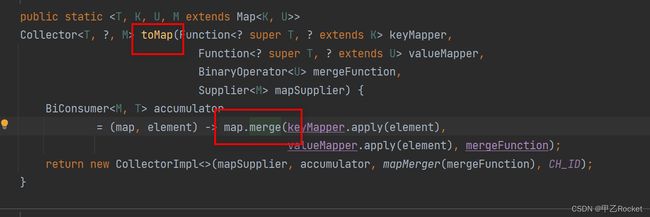Java容器使用注意点
前置:问题
- 判空
- 集合转map
- 集合遍历
- 集合去重
- 集合转数组
- 数组转集合
一:集合判空
《阿里巴巴 Java 开发手册》的描述如下:
判断所有集合内部的元素是否为空,使用 isEmpty() 方法,而不是 size()==0 的方式。
我们在开发中也常用Spring提供的CollectionUtil.isEmpty(list)
// ConcurrentHashMap 的 size() 方法和 isEmpty() 方法的源码。
public int size() {
long n = sumCount();
return ((n < 0L) ? 0 :
(n > (long)Integer.MAX_VALUE) ? Integer.MAX_VALUE :
(int)n);
}
final long sumCount() {
CounterCell[] as = counterCells; CounterCell a;
long sum = baseCount;
if (as != null) {
for (int i = 0; i < as.length; ++i) {
if ((a = as[i]) != null)
sum += a.value;
}
}
return sum;
}
public boolean isEmpty() {
return sumCount() <= 0L; // ignore transient negative values
}
Spring中的源码
// 判null+判内容
public static boolean isEmpty(@Nullable Collection<?> collection) {
return (collection == null || collection.isEmpty());
}
Spring底层是直接使用isEmpty进行判空的。
这是因为 isEmpty() 方法的可读性更好,并且时间复杂度为 O(1)。
绝大部分我们使用的集合的 size() 方法的时间复杂度也是 O(1),不过,也有很多复杂度不是 O(1) 的,比如 java.util.concurrent 包下的某些集合(ConcurrentLinkedQueue\ConcurrentHashMap…)出于时间复杂度的考虑
二:集合转Map
《阿里巴巴 Java 开发手册》的描述如下:
在使用 java.util.stream.Collectors 类的 toMap() 方法转为 Map 集合时,一定要注意当 value 为 null 时会抛 NPE 异常。
class Dog {
private String id;
private String sex;
}
List<Dog> list = new ArrayList<>();
list.add(new Dog("1212121","公"));
// value为null值,会报npe
list.add(new Dog("435",null));
// 空指针异常
list.stream().collect(Collectors.toMap(Dog::getId, Dog::getSex));
异常原因
集合遍历
《阿里巴巴 Java 开发手册》的描述如下:
不要在 foreach 循环里进行元素的 remove/add 操作(这个问题我踩过坑,和你想删的东西绝对不一样)。remove 元素请使用 Iterator 方式,如果并发操作,需要对 Iterator 对象加锁。
通过反编译你会发现 foreach 语法底层其实还是依赖 Iterator 。不过, remove/add 操作直接调用的是集合自己的方法,而不是 Iterator 的 remove/add方法
这就导致 Iterator 莫名其妙地发现自己有元素被 remove/add ,然后,它就会抛出一个 ConcurrentModificationException 来提示用户发生了并发修改异常。这就是单线程状态下产生的 fail-fast 机制。
Java8之后使用removeIf
List<Integer> list = new ArrayList<>();
for (int i = 1; i <= 10; ++i) {
list.add(i);
}
// 这个蛮好用的
list.removeIf(filter -> filter % 2 == 0); /* 删除list中的所有偶数 */
System.out.println(list); /* [1, 3, 5, 7, 9] */
集合去重
《阿里巴巴 Java 开发手册》的描述如下:
可以利用 Set 元素唯一的特性,可以快速对一个集合进行去重操作,避免使用 List 的 contains() 进行遍历去重或者判断包含操作。
// Set 去重代码示例
// 无hash冲突时时间复杂度O(1)
public static <T> Set<T> removeDuplicateBySet(List<T> data) {
if (CollectionUtils.isEmpty(data)) {
return new HashSet<>();
}
return new HashSet<>(data);
}
// List 去重代码示例
//时间复杂度O(n) ,跟进去看contains方法就可以看出来
public static <T> List<T> removeDuplicateByList(List<T> data) {
if (CollectionUtils.isEmpty(data)) {
return new ArrayList<>();
}
List<T> result = new ArrayList<>(data.size());
for (T current : data) {
if (!result.contains(current)) {
result.add(current);
}
}
return result;
}
// testMy
List<Integer> integers = Arrays.asList(1, 1, 1, 12, 32, 32, 3245, 3123, 6, 6);
// 推荐去重方式
HashSet<Integer> integers1 = new HashSet<>(integers);
System.out.println(JSON.toJSONString(integers1));
集合转数组
《阿里巴巴 Java 开发手册》的描述如下:
使用集合转数组的方法,必须使用集合的 toArray(T[] array),传入的是类型完全一致、长度为 0 的空数组。
toArray(T[] array) 方法的参数是一个泛型数组,如果 toArray 方法中没有传递任何参数的话返回的是 Object类 型数组。
String [] s= new String[]{
"dog", "lazy", "a", "over", "jumps", "fox", "brown", "quick", "A"
};
List<String> list = Arrays.asList(s);
Collections.reverse(list);
//没有指定类型的话会报错
s=list.toArray(new String[0]);
由于 JVM 优化,new String[0]作为Collection.toArray()方法的参数现在使用更好,new String[0]就是起一个模板的作用,指定了返回数组的类型,0 是为了节省空间,因为它只是为了说明返回的类型。详见:https://shipilev.net/blog/2016/arrays-wisdom-ancients/
数组转集合
《阿里巴巴 Java 开发手册》的描述如下:
使用工具类 Arrays.asList() 把数组转换成集合时,不能使用其修改集合相关的方法, 它的 add/remove/clear 方法会抛出 UnsupportedOperationException 异常。
Arrays.asList()在平时开发中还是比较常见的,我们可以使用它将一个数组转换为一个 List 集合。
String[] myArray = {"Apple", "Banana", "Orange"};
List<String> myList = Arrays.asList(myArray);
//上面两个语句等价于下面一条语句
List<String> myList = Arrays.asList("Apple","Banana", "Orange");
JDK源码
/**
*返回由指定数组支持的固定大小的列表。此方法作为基于数组和基于集合的API之间的桥梁,
* 与 Collection.toArray()结合使用。返回的List是可序列化并实现RandomAccess接口。
*/
public static <T> List<T> asList(T... a) {
return new ArrayList<>(a);
}

